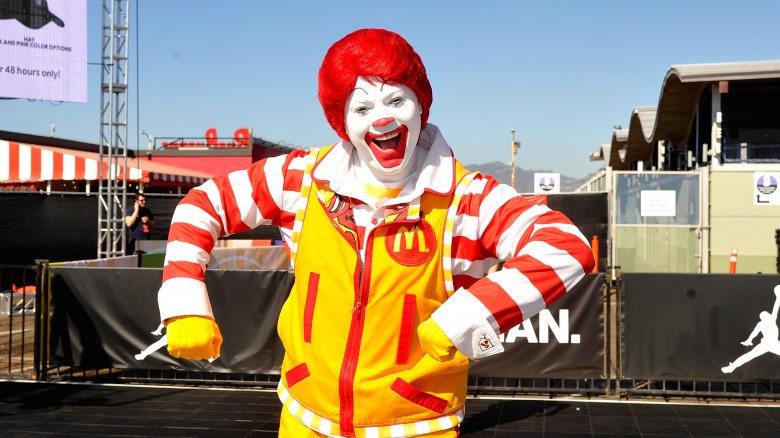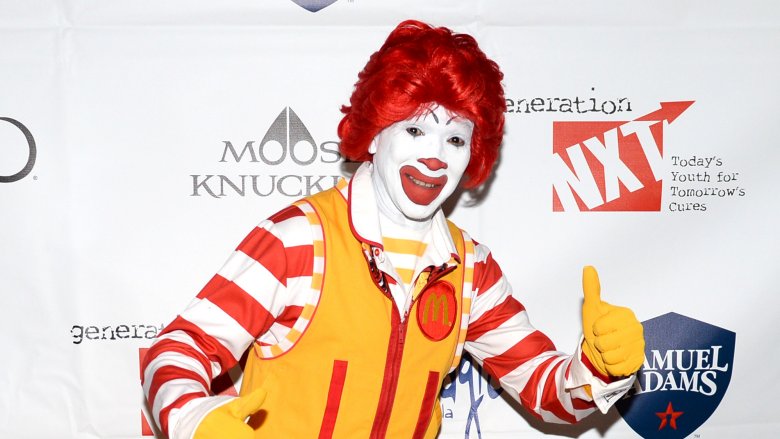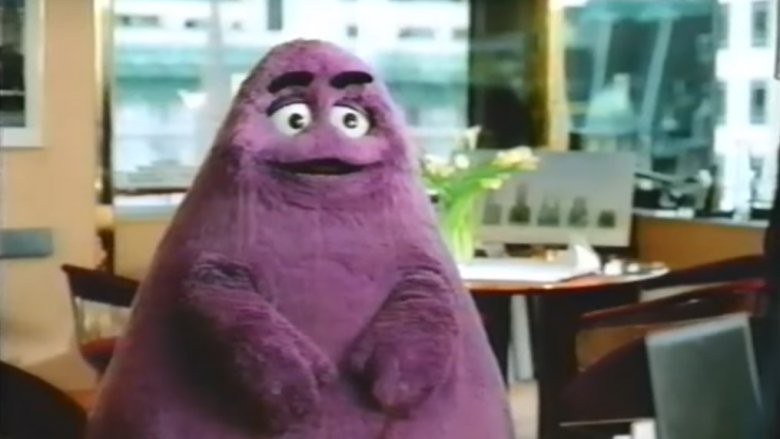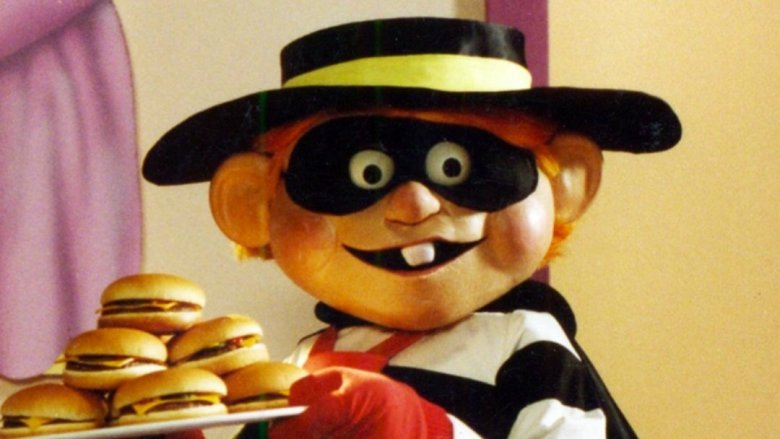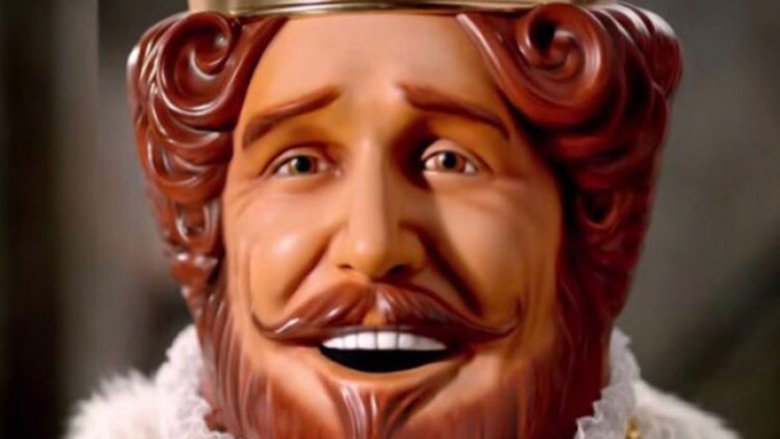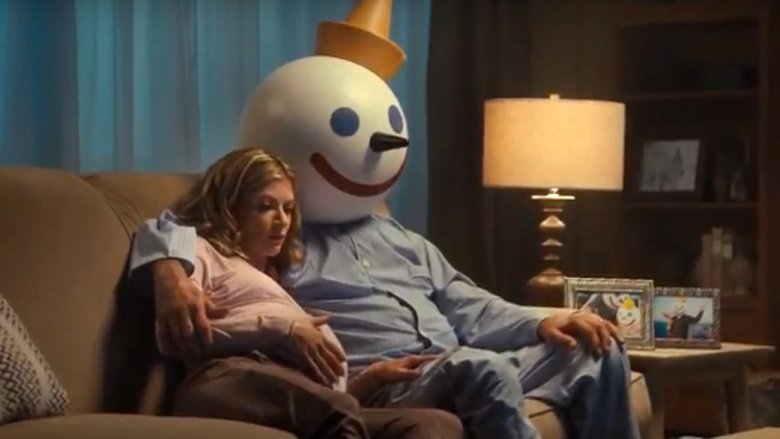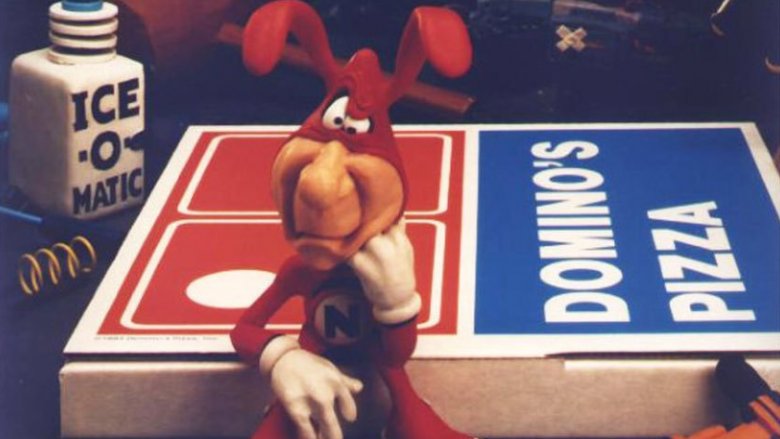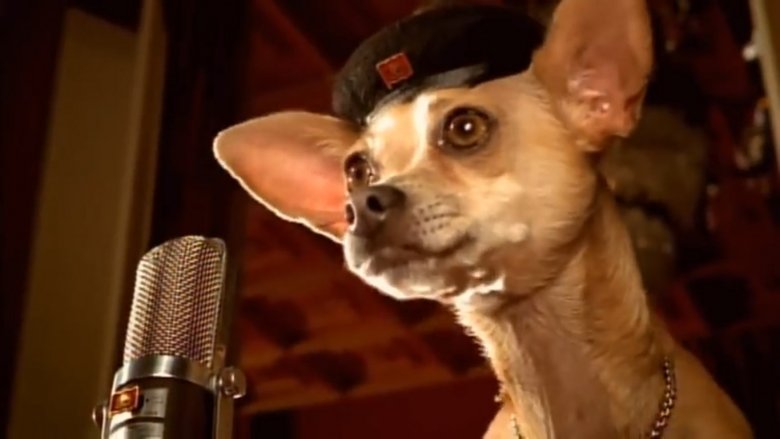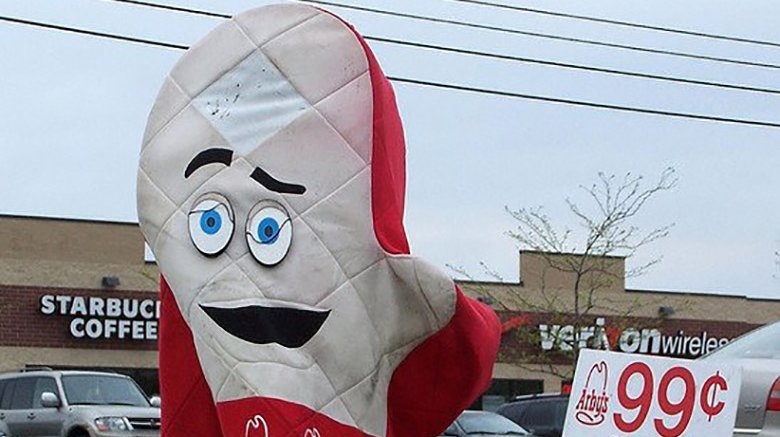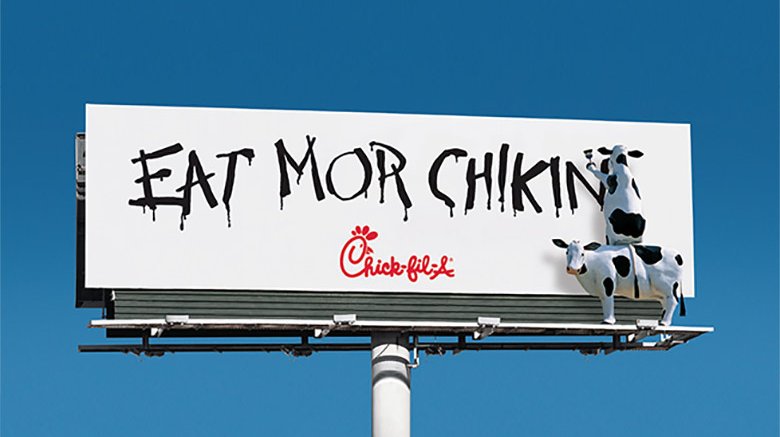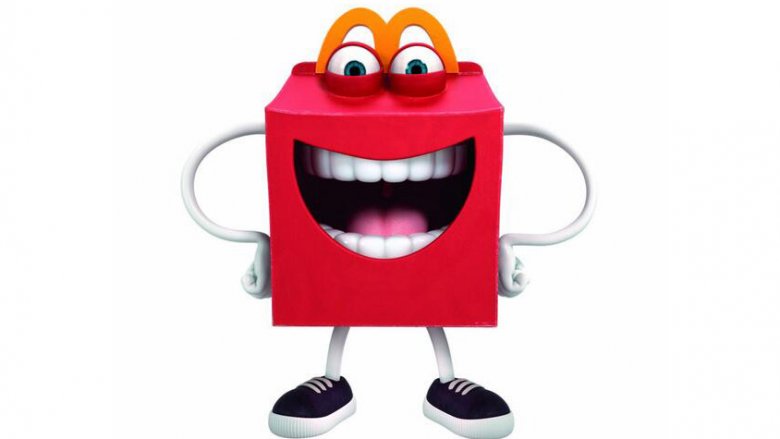Weird Things Everyone Just Ignores About Famous Fast Food Mascots
Fast food generally sells itself. It's cheap, quick, and when you have a particular craving and are not in the mood to be picky, it can taste pretty good. Even with all that going for it, fast food chains have spent millions of dollars on marketing teams to come up with gimmicky mascots to get people in the door. Arguably the most famous of these is Ronald McDonald, but there have been a host of imitators who have followed in his footsteps — some more successful than others.
While many of these mascots might seem rather dull on the surface, look a little closer and you'll begin to notice some strange, maybe even unsettling qualities. Some of these fast food mascots come and go in the blink of an eye and others have been kicking around for decades. They all have one goal in common, however, to get you in the door and eating. If you happen to ignore their odd traits, that's on you.
Ronald McDonald's been creeping people out for years
Between horror movies like 2017's It and that bizarre rash of terrorizing clown sightings in 2016, clowns aren't exactly delighting folks much these days. McDonald's is well aware of this and has even scaled back the visibility of its red-haired, yellow jumpsuit-wearing pitchman, Ronald McDonald. Ronald's persona has actually been creeping folks out for decades.
Take the first incarnation of Ronald for example. Created in 1963, and portrayed by actor Willard Scott, Ronald outfitted himself with a tray of food on his head, a paper cup nose, and a tray on his belt that constantly replenished hamburgers. Basically, he was a clown with magic powers that decorated himself in fast food garbage. Uh, yeah, that's not bizarre at all.
The real creepiness boils down to Ronald's mission: get kids hooked on McDonald's. The character was created solely for the purpose of enticing children to bug their parents until they got some Mickey Ds. One would think that Ronald McDonald would be constantly scarfing down McNuggets and fries, but nope, you'll never see him eat the stuff. So, let's recap: a creepy clown who originally draped himself in paper trash, lures kids in to eat fast food, but never actually eats any himself. No wonder people want McDonald's to retire Ronald.
Grimace was a child-terrorizing monster
As creepy as Ronald might be, he's got nothing on the purple blob known as Grimace that tags along with him. What exactly is Grimace? Just a blob with limbs and eyes? A mythical beast born from the bowels of McDonaldland? That question may never be fully answered, but what we do know is that Grimace used to be kinda evil and kids were scared of him. Before he was the purple glob that he is today, Grimace was a four-armed beast with the intent of stealing every milkshake he could get his chubby hands on.
Roy Bergold Jr., the former chief creative officer at McDonald's, revealed that when he was initially created, Grimace drove children away, rather than persuaded them to come to the fast food restaurant. "The original Grimace was scaly, mean-looking, had four arms, and had no charm whatsoever," Bergold wrote for QSR Magazine. "He scared kids. We changed him to a soft, plush, two-armed blob of a sweetheart who only wanted McDonald's milkshakes and to hang out with Ronald."
Okay, so maybe a purple blob that craves milkshakes may not be the scariest thing in the world. Then again, do you really want to see what Grimace is capable of when he doesn't get his milkshakes?
Hamburglar was originally an incoherent creepy old man
It may seem like we're ragging on McDonald's pretty hard, but when McDonaldland has an entire ecosystem of weirdos running around in it, it's kinda difficult not to notice a few things. The Hamburglar is without a doubt the most threatening McDonald's character. Just his name tells you that he's up to no good and lives a life of crime.
The Hamburglar first appeared on the scene in 1971 and he was hardly the one-toothed goof that he is today. Keeping with tradition, McDonald's made the Hamburglar unnecessarily weird in the early days and he was a pointy-nosed old man with scraggly hair created by a marketing team to promote McDonald's new PlayPlaces. That's right, some geniuses thought a creepy old man who looked like a villain from Grimm's fairy tales would be ideal for promoting a playground. Even more confusing, Hamburglar wore a shirt that read "loan jogger" and spoke only in gibberish.
The Hamburglar's image morphed over time, the loan jogger shirt was ditched and he eventually adopted the catchphrase "robble, robble."
By the early 2000s, the Hamburglar was a lot less visible, that is until his comeback in 2015. In order to promote its Sirloin Third Pound burger, McDonald's brought Hamburglar back, only now he was an adult man wearing a trench coat and cargo pants. And he still steals burgers *Sigh* Nice try, McDonald's, but he might be more weird now than ever.
Burger King's King was mentally unstable
If there's one thing more upsetting than a clown trying to sell you a hamburger, it's a weirdo wearing a giant plastic king head who creeps into your room at night. Burger King was struggling in the early 2000s to keep up with McDonald's, so they hired a marketing firm to create the Burger King King and to nobody's surprise, people hated him.
The King hardly ever spoke — except for that odd time he adopted Budweiser's "whassup" — and presumably couldn't even eat burgers. Because of that plastic head and all. What he could do was lurk outside your bedroom window, crawl into your bed uninvited, flee the police, and assault you. Yes, in one commercial Burger King seemingly admitted their mascot was an unstable lunatic when he went berserk in an office before being tackled by psych ward staff.
Upon the King being mostly retired, Alex Maccedo, SVP of Burger King's marketing said in 2011, "People want a reason to go back to Burger King... There are no plans to bring the King back anytime soon." Unfortunately, they did bring him back in 2015, though his appearances have been few and far between.
Jack in the Box's Jack is married to a regular woman
There's just something about fast food restaurants thinking people want a mascot with a giant plastic head. Take for example, Jack Box. This ping pong head bozo is the pitchman for the fast food chain Jack in the Box, and while he may not be that strange on the surface, just dig a little deeper.
Jack Box mentions both on Twitter and in commercials that he's married to a woman named Cricket. Unlike Jack, Cricket doesn't have a ping pong ball for a head and appears to be a normal woman — who sleeps with Jack. This isn't a marriage strictly for appearances, Cricket and Jack have a child who also has a ping pong head. It would be one thing if Jack had his head horribly disfigured while making fries or something and had to wear the ping pong head out of shame, but he appears to be an entirely different species. The only problem is that Jack's mother appears to be an regular human female with no ping pong head while his father has a ping pong head in the commercials. WHAT. IS. GOING. ON?!
The Dominos Noid drove a man to commit robbery and suicide
From Peter Gabriel's "Sledgehammer" music video to the California Raisins' TV specials, claymation was all the rage in the 1980s and Domino's jumped on the bandwagon with the Noid. The pizza-ruining miscreant was incredibly popular for several years, until tragedy struck. The popularity of the Noid led to toys and video games, but wasn't a hit with everyone, especially a 22-year-old man named Kenneth Noid.
In 1989, Kenneth Noid walked into an Atlanta Domino's with a .357 magnum revolver, took two employees hostage and demanded $100,000 in ransom money during a five-hour standoff. Noid suffered from schizophrenia and believed the Noid was modeled after him and had been targeted by the pizza chain. The press jumped on the story with headlines like "Domino's Hostages Couldn't Avoid the Noid this Time." Sadly, Kenneth Noid couldn't get past the idea that Domino's was behind a nefarious campaign to ruin him and spent three months in a mental hospital before eventually killing himself in 1995. Soon after, the Domino's mascot found himself out of a gig
Taco Bell's Chihuahua wasn't so amusing to the Hispanic community
People love cute dogs and they love tacos. Put'em together and you've got a hit $500 million advertising campaign smash! Only not everybody was in love with the chihuahua that trotted around saying "Yo quiero Taco Bell." Some in the Hispanic community saw it as an insult against them and took offense to the fast food chain using the dog breed to sell its questionable Tex-Mex fare. "To equate a dog with an entire ethnic population is outrageous, despicable, demeaning and degrading," Mario Obledo, then-president of the California Coalition of Hispanic Organizations, said in 1998.
The Taco Bell chihuahua, voiced by comedian Carlos Alazraqui, may have been well-meaning and well-liked by many, but it wasn't enough to keep the pooch employed. The mascot was officially retired in 2000. (Don't worry about the actual dog, Gidget, she went on to star in Legally Blonde 2.) To make matters worse for Taco Bell, they were found to be in breach-of-contract to the tune of $42 million dollars in a 2009 involving a lawsuit with the men behind the idea of the mascot.
Hopefully, the fast food industry learned a valuable PR lesson in the end. People might love dogs, but that doesn't mean everyone will be cool with dressing a dog up in a beret and having it say "Viva Gorditas!"
Arby's Oven Mitt was a dud from the start
You gotta hand it to Arby's, their oven mitt character wasn't creepy or offensive in any way, so it should have been a hit. Sometimes a little mystery can work well, but the mitt just didn't have it.
The glove was a snooze fest from the beginning. The Arby's Oven Mitt made its debut in 2003 and Arby's reportedly spent around $85 million in the creation and marketing of the character that was to highlight the cooking process of the fast food chain's roast beef. Research was conducted, celebrity Tom Arnold was brought in to voice the mitt, and the commercials were launched.
The mitt sang "Volare" and even had collectibles made around it. Unfortunately, the Oven Mitt wasn't funny enough for adults and not appealing enough for kids. Mitt only made it two years before it was cast off to the land of fast food mascot misfits, or simply put in a drawer and forgotten about. Probably the drawer.
Chick-fil-A's Cows are oddly okay with farm animal slaughter
Chick-fil-A's cows with the horrible spelling skills have been nothing short of a colossal success for the Georgia-based chicken chain. Unlike every other mascot on our list, the cows don't do commercials, but made their mark with billboards back in 1995. It all started with the first billboard that read "Eat Mor Chikin," but later progressed to billboards that read "U Wanna Peece Of Me?" with a cow wearing a goofy chicken head or "Chikin: Part Of A Ballansed Diet."
As clever as the marketing campaign is, it's also sorta twisted that one farm animal is advocating for the murder of another farm animal. Reddit has pointed this out before, calling the marketing scheme "creepy." Protesters at a Florida location in 2017 even stormed the restaurant dressed as bloody cows and chickens in an effort to discourage people from eating the food. As delicious as the chicken might be, perhaps it's best not to let your imagination dwell too much on the sort of sinister things those cows could be up to behind the scenes.
McDonald's Happy Meal mascot didn't make people happy in any way
We started with McDonald's and now we've come full circle, zeroing in on their latest mascot that is just too strange for most appetites. We're talking of course about "Happy," the cartoon Happy Meal mascot that was reportedly born in France back in 2009, but didn't make is way over to give Americans the willies until 2014. The company debuted Happy on Twitter and was immediately met with reactions like "This looks like the monster that killed my uncle" and "It takes a long time to genetically engineer cardboard to eat your children." Oof, probably not the reaction McDonald's was hoping for with Happy.
The red box figure with bulbous eyeballs, and a grin that would make the Cheshire cat flinch, was intended to encourage children to get fruits, veggies, and beverage options like milk and water with their Happy Meals. A McDonald's spokesperson responded to the negative press saying "not all comments reflect the broader view" and the fast food giant even pushed forward with Happy on Twitter.
As for where Happy is these days, well, he's certainly not doing much of anything with McDonald's. Maybe check under your bed.
